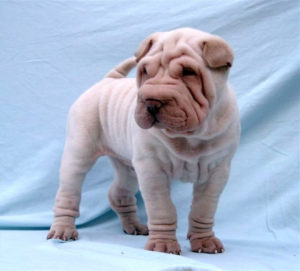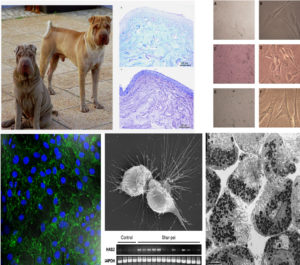La Dott.ssa Giordana Zanna è autrice e co-autrice di articoli scientifici pubblicati su riviste internazionali sui cani di razza Shar pei.
Gli studi condotti hanno riguardato la patogenesi di un disordine ereditario della stessa razza Shar Pei, definito mucinosi o ialunorosi cutanea.


Abstract
Cutaneous mucinosis affects primarily shar-pei dogs. Hyaluronic acid (HA) is considered to be the main component of mucin and CD44 is the major cell surface receptor of HA, necessary for its uptake and catabolism. The aims of this study were to identify the composition of the mucin in cutaneous mucinosis of shar-pei dogs, investigate the correlation between the deposition of HA and the expression of CD44, and determine whether shar-pei dogs with cutaneous mucinosis presented with elevated levels of serum HA
Abstract
Shar pei dogs are known for the distinctive feature of thick, wrinkled skin as a consequence of high dermal mucin content. Excessive dermal deposition of mucinous substance leading to severe skin folding, and/or to the more severe vesicular form characterized by dermal vesicles or bullae, is highly prevalent in this breed and is known as idiopathic mucinosis. Hyaluronic acid (HA) is the main component that accumulates in the dermis
Abstract
The Chinese shar-pei dog is known for its distinctive feature of wrinkled and thickened skin, defined as primary or hereditary cutaneous mucinosis. In a recent report, we identified the mucinous material deposited in the shar-pei skin as the polysaccharide hyaluronan (HA). In the present work, the molecular and cellular mechanisms underlying this phenotype have been identified in dermal fibroblasts isolated from shar-pei dogs...
Abstract
Hereditary periodic fever syndromes are characterized by recurrent episodes of fever and inflammation with no known pathogenic or autoimmune cause. In humans, several genes have been implicated in this group of diseases, but the majority of cases remain unexplained. A similar periodic fever syndrome is relatively frequent in the Chinese Shar-Pei breed of dogs. In the western world, Shar-Pei have been strongly selected for a distinctive thick and heavily folded skin. In this study, a mutation affecting both these traits was identified
Abstract
To determine whether high-frequency diagnostic ultrasonography is useful for assessment of skin thickness in Shar-Peis...